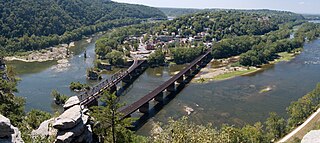
Harpers Ferry National Historical Park, originally Harpers Ferry National Monument, is located at the confluence of the Potomac and Shenandoah rivers in and around Harpers Ferry, West Virginia. The park includes the historic center of Harpers Ferry, notable as a key 19th-century industrial area and as the scene of John Brown's failed abolitionist uprising. It contains the most visited historic site in the state of West Virginia, John Brown's Fort.
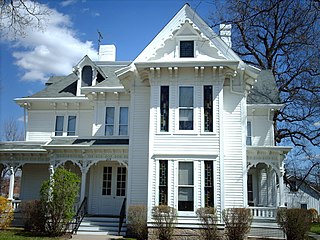
The Harry S. Truman Historic District is a National Historic Landmark District encompassing sites closely associated with US President Harry S. Truman in Independence, Missouri. It includes the Truman Home at 219 North Delaware, Truman's home for much of his adult life and now a centerpiece of the Harry S. Truman National Historic Site, and the Truman Presidential Library. The district was listed on the National Register of Historic Places in 1971, and was designated a National Historic Landmark in 1974. When first listed, the district included only the two buildings and a corridor joining them. It was substantially enlarged in 2011 to include more sites and the environment in which Truman operated while living in Independence.
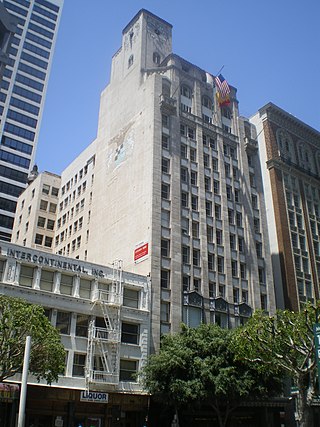
The James Oviatt Building, commonly referred to as The Oviatt Building, is an Art Deco highrise in Downtown Los Angeles located on Olive Street, half a block south of 6th St. and Pershing Square. In 1983, the Oviatt Building was listed in the National Register of Historic Places. It is also designated as a Los Angeles Historic-Cultural Monument.

Kaufman-Straus was a local department store that operated in Louisville, Kentucky, from 1879 to 1969. In 1879, local retail clerk Henry Kaufman opened the first store on Jefferson between 7th and 8th. Four years later, Benjamin Straus entered into partnership with Kaufman. In 1887, the Kaufman-Straus store moved to South 4th Street in space leased from the Polytechnic Society of Kentucky. The new flagship store opened in 1903, at 533-49 South 4th Street, designed by local architect Mason Maury. In 1924, Kaufman-Straus was acquired by City Stores Company and the following year the flagship store underwent extensive renovations. City Stores rebranded the company as Kaufman's in 1960. It operated two stores in suburban Louisville at The Mall and Dixie Manor. In 1969, Kaufman's was acquired by L. S. Ayres, and the downtown Louisville store was subsequently closed in 1971.

The Centreville Historic District is a historic district in Centreville, Alabama. It includes 7.5 acres (3.0 ha) and twenty buildings, including the Bibb County Courthouse. It is roughly bounded by Walnut Street, and the East and West Court squares. It features examples of Victorian architecture. The district was added to the National Register of Historic Places on October 19, 1978.

The Palace Clothing Company Building in Kansas City, Missouri is a building constructed in 1924. It was listed on the National Register of Historic Places in 1985.

Roslyn National Bank and Trust Company Building is a historic commercial building located at Roslyn in Nassau County, New York. It was designed by architect William Tubby and built in 1931. Located on the corner of Old Northern Boulevard and Remsen Avenue, it is a one-story, rectangular brick building with a flat roof in a modified Classical Revival style. The front facade is three bays wide and features a Tuscan order wood portico with paired columns.
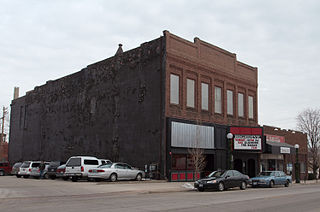
Vriner's Confectionery is a historic confectionery store located at 55 Main Street in Champaign, Illinois.

Citizens Bank is one of the original buildings in the downtown area of Stillwater and only one of two buildings in the town with this early architectural style of the Nineteenth Century.
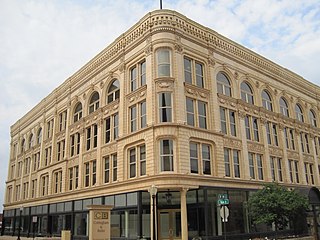
The Security Building, also known as the Stampfer Building, is a historic structure in Dubuque, Iowa, United States. The cream-colored building is associated with the J. F. Stampfer Co. department store.
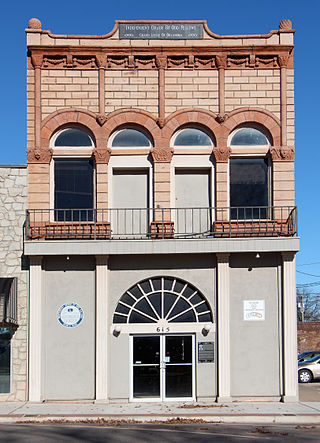
The Wolleson–Nicewander Building, also known as the Triton Insurance Company Building, was built in 1900, and is within the Perry Courthouse Square Historic District in Perry, Oklahoma. Its builder, T. E. Wollenson, was a sailor and merchant who had immigrated from Denmark, and settled in Perry. Wollenson bought a lot on the north side of what is now called Courthouse Square. He then built a two-story building, that soon housed the Nicewander Clothing store. Later occupants included a dry goods store, a tire and auto supply store, and an insurance company headquarters.
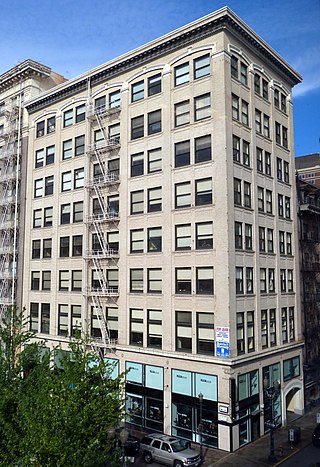
The Woodlark Building is a historic commercial building in downtown Portland, Oregon, United States that is listed on the National Register of Historic Places. The nine-story building was designed by Doyle, Patterson & Beach, and constructed in 1911–12. It has been described as "one of Portland's earliest commercial skyscrapers". From its completion until 1924, it was the headquarters of two jointly owned and very similarly named pharmaceutical companies based in Portland, the retail Woodard, Clarke & Company, and the wholesale Clarke-Woodward Company. It was converted into an office building in 1924. The retail space on the ground floor, mezzanine and basement has held a variety of businesses, in succession over the building's history, among the longest-lasting ones being a drugstore (1912–1927), a Sherman Clay piano and music store (1930–1974), and an independent shoe store (2000–2016).
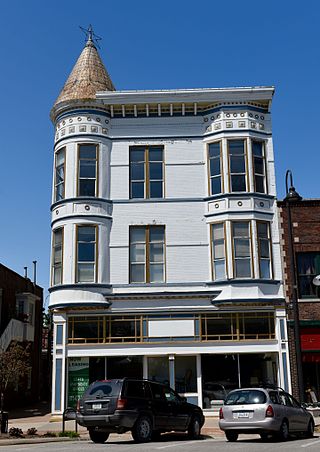
The Gobble and Heer–Spurgeons Building is a historic building located in Fairfield, Iowa, United States. It housed two long-time businesses and its significance highlights the commercial development of the city's public square. The building is a three-story, brick, Queen Anne commercial building that was built by Ed Hunt and E. A. Howard on the north side of the town square in 1892. They did not occupy the building themselves, but rented to Harry Booker for his clothing store and the Bevering Cigar Store. Lee T. Gobble and Charles H. Heer bought the clothing store from the Booker estate in 1899. Both the clothing store and the cigar store remained in the building until the 1930s when the entire first floor was taken over by Spurgeons. The upper floors were a mix of offices, apartments, and a lodge hall for the Knights of Pythias and the Pythian Sisters on the third floor. The building was listed on the National Register of Historic Places in 2015.

Parker's Opera House, also known as Opera House Store, Woolworth's and Parker Place, is a historic building located in Mason City, Iowa, United States. It was designed by the prominent Des Moines architect William Foster. Cousins H. G. and A. T. Parker built this structure as an opera house, which was the first one in the community. While it initially filled a need in Mason City, it was replaced by more modern theatres around the turn of the 20th century. The third floor was created in the building in 1909 when it was placed across the middle of the auditorium. The first floor initially housed a clothing store, and F. W. Woolworth Company occupied it beginning in the mid-1920s, and the upper floors housed the local offices of the Standard Oil Company at the same time. The two-story addition in the rear was built in the 1960s. The first floor was redesigned in 1997 for Central Park Dentistry. The upper floors were converted into apartments in 2013.

T.S. Martin and Company, also known as Karlton's, Fishgalls & Cameo, is a historic building located in Sioux City, Iowa, United States. It is an L-shaped structure that fronts both Fourth Street and Nebraska Street. It was occupied by one of three locally owned department stores from 1894 to 1919. The buildings on Fourth Street were originally built in 1885. T.S. Martin and Company itself dates from 1880 when Thomas Sanford Martin opened a dry goods store in rented commercial space. He first acquired 515-517 Fourth Street in 1885, which he leased to a clothing store, and his brother Louis opened T.S. Martin and Company Shoes by leasing 519 Fourth Street the same year.

The Winter Building is a historic building in Montgomery, Alabama, U.S. The 3-story structure was built as a bank branch with a telegraph office upstairs.
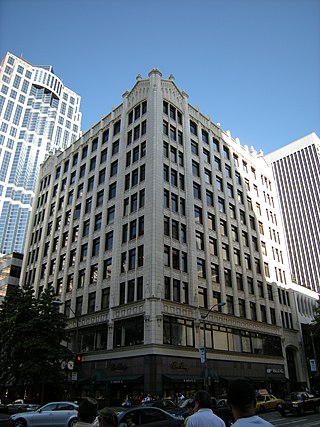
The Liggett Building, also referred to as the Fourth & Pike Building, is a historic 10-story office building at 1424 4th Avenue in downtown Seattle, Washington. It was built in 1927 by the Louis K. Liggett Company, leasing the property from the estate of local pioneer George Kinnear, to house the first Seattle location of their national drug store chain. Liggett's would break their 99-year lease on the building only a few years later after having opened a second location only a block away proved financially unwise during the Great Depression. The building received its current name after a 1933 renovation. Designed by Lawton & Moldenhour in the Gothic revival style, it is clad entirely in locally manufactured terracotta. It is an official Seattle City Landmark and was listed on the National Register of Historic Places on August 31, 2011.
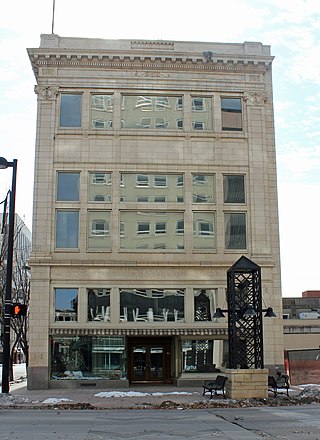
Woolf Brothers Clothing Company is a historic building in Wichita, Kansas. It is listed in the National Register of Historic Places. It is at 135 East Douglas Avenue. It was built in 1922 and replaced Greenfield's Clothing and Furnishings for Men. The building was designed by Lorenz Schmidt and opened in January 1923.





















